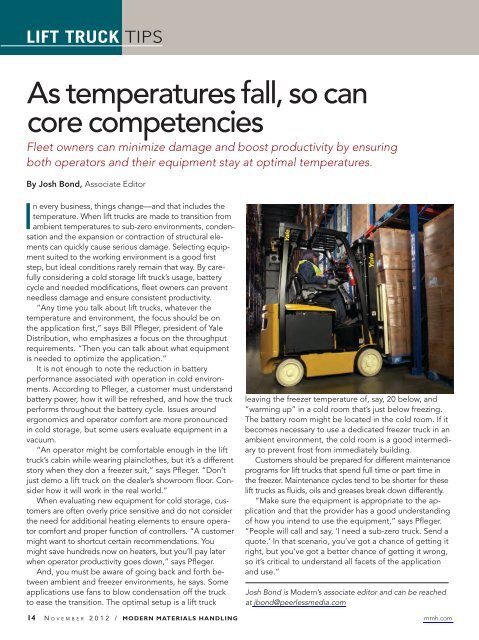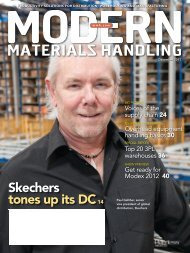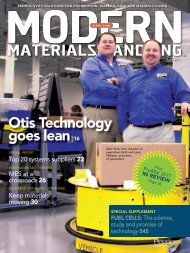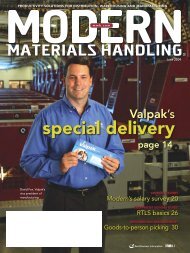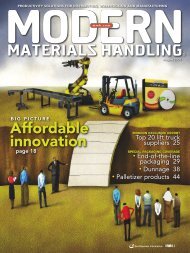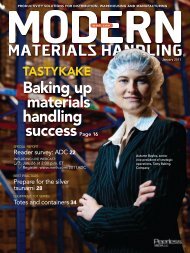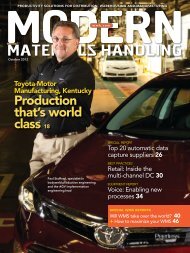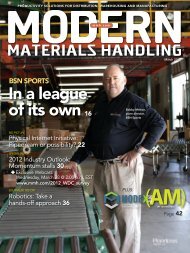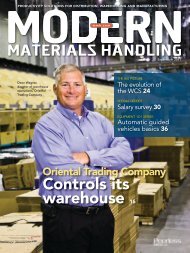Modern Materials Handling - November 2012
Modern Materials Handling - November 2012
Modern Materials Handling - November 2012
You also want an ePaper? Increase the reach of your titles
YUMPU automatically turns print PDFs into web optimized ePapers that Google loves.
lift truck TIPSAs temperatures fall, so cancore competenciesFleet owners can minimize damage and boost productivity by ensuringboth operators and their equipment stay at optimal temperatures.By Josh Bond, Associate EditorIn every business, things change—and that includes thetemperature. When lift trucks are made to transition fromambient temperatures to sub-zero environments, condensationand the expansion or contraction of structural elementscan quickly cause serious damage. Selecting equipmentsuited to the working environment is a good firststep, but ideal conditions rarely remain that way. By carefullyconsidering a cold storage lift truck’s usage, batterycycle and needed modifications, fleet owners can preventneedless damage and ensure consistent productivity.“Any time you talk about lift trucks, whatever thetemperature and environment, the focus should be onthe application first,” says Bill Pfleger, president of YaleDistribution, who emphasizes a focus on the throughputrequirements. “Then you can talk about what equipmentis needed to optimize the application.”It is not enough to note the reduction in batteryperformance associated with operation in cold environments.According to Pfleger, a customer must understandbattery power, how it will be refreshed, and how the truckperforms throughout the battery cycle. Issues aroundergonomics and operator comfort are more pronouncedin cold storage, but some users evaluate equipment in avacuum.“An operator might be comfortable enough in the lifttruck’s cabin while wearing plainclothes, but it’s a differentstory when they don a freezer suit,” says Pfleger. “Don’tjust demo a lift truck on the dealer’s showroom floor. Considerhow it will work in the real world.”When evaluating new equipment for cold storage, customersare often overly price sensitive and do not considerthe need for additional heating elements to ensure operatorcomfort and proper function of controllers. “A customermight want to shortcut certain recommendations. Youmight save hundreds now on heaters, but you’ll pay laterwhen operator productivity goes down,” says Pfleger.And, you must be aware of going back and forth betweenambient and freezer environments, he says. Someapplications use fans to blow condensation off the truckto ease the transition. The optimal setup is a lift truckleaving the freezer temperature of, say, 20 below, and“warming up” in a cold room that’s just below freezing.The battery room might be located in the cold room. If itbecomes necessary to use a dedicated freezer truck in anambient environment, the cold room is a good intermediaryto prevent frost from immediately building.Customers should be prepared for different maintenanceprograms for lift trucks that spend full time or part time inthe freezer. Maintenance cycles tend to be shorter for theselift trucks as fluids, oils and greases break down differently.“Make sure the equipment is appropriate to the applicationand that the provider has a good understandingof how you intend to use the equipment,” says Pfleger.“People will call and say, ‘I need a sub-zero truck. Send aquote.’ In that scenario, you’ve got a chance of getting itright, but you’ve got a better chance of getting it wrong,so it’s critical to understand all facets of the applicationand use.”Josh Bond is <strong>Modern</strong>’s associate editor and can be reachedat jbond@peerlessmedia.com14 N o v e m b e r 2 0 1 2 / <strong>Modern</strong> <strong>Materials</strong> <strong>Handling</strong> mmh.com


